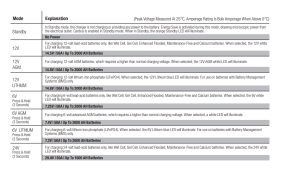Your advice has been taken to heart and followed. You can see that in the was that the rack is now wired. Thank you for all you have contributed to my effort to make this off grid work will.
Only thing I can say is that the engineers of the the NOCO battery charger are most likely smarter engineers than I ever was. I read the manual and trust their design to do what they say. They say it is computerized and analyzes the battery, then charges accordingly to its needs. I have to believe that.
Sorry, I am so frustrating for you. I am going to bow out of this one.
Again, thanks for your help.
Ken
I'll chime in.
It is NOT smart enough to know if it's sending too much current to the battery. That's in evidence by the fact that it says there's a 10A mode.
Per the manual:
https://no.co/media/nocodownloads/format/g/e/geniuspro50_user_guide_10.12.2022a.pdf
13.) 10A Mode Button Push to activate Reduced Charge Current Mode.
If you are using the Noco to charge one of your 12V batteries, you need to press that button. The charger is not smart enough to know that it's going to damage your battery by sending it 50A.
I'm going to repeat myself. I would get better results in every situation with a programmable power supply or charger than the Noco could ever produce in terms of PROPER charging of a
specific battery.
The Noco uses generic values that apply to certain
types of batteries:

For example, under 12V for WET, it charges to 14.5V. If you put this charger on a Rolls-Surrette or Trojan 12V battery, you would UNDER-charge them as they are 15.0V and 14.82V, respectively.
All batteries have very specific "fully charged" criteria according to the manufacturer. There's no way the Noco can know these values, so it's just going to use something that's typical for that class of battery.
The Noco is a fine charger with important features, namely the "force," "supply," and "repair" modes, as they go above and beyond a standard charger; however, you can't fall for the marketing. Do not place blind faith in it. It doesn't know about specific batteries because it can't due to the hundreds (thousands?) of different battery brands and types that all may be slightly different.
Here's a little something that should shake your faith in them:


They only give you a caution that is vague.
What they should have said is:
These modes are ONLY for WET lead acid batteries. Repair mode on Sealed, AGM or GEL batteries will damage them.
So, before you wonder if it could help, NEVER use the repair mode on your batteries unless you want to damage them.






